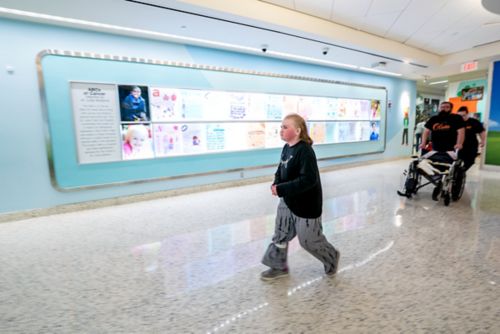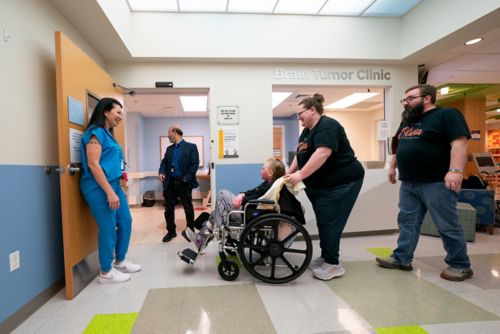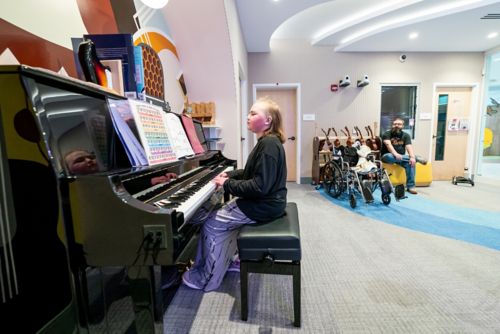St. Jude Family of Websites
Explore our cutting edge research, world-class patient care, career opportunities and more.
St. Jude Children's Research Hospital Home

- Fundraising
St. Jude Family of Websites
Explore our cutting edge research, world-class patient care, career opportunities and more.
St. Jude Children's Research Hospital Home

- Fundraising
Brain tumors in children are among the most challenging cancers to treat for an array of reasons.
The cancer’s location, the therapy’s impact on developing minds, and the molecular differences driving these malignancies are just a few factors that influence treatment outcomes. With a focus on translational research that grounds new clinical developments in the latest laboratory science, St. Jude is advancing the care and treatment of pediatric patients with brain tumors by learning more about the molecular underpinnings of those diseases.
Over the past several decades, molecular analyses, such as DNA-methylation profiling and next-generation genomic sequencing, have revealed molecular subgroups across various tumor types. By combining information about these molecular characteristics with findings from other diagnostic methods, such as medical imaging and histopathology, physicians can make an integrated diagnosis and select the best treatment plan. With each discovery, scientists add elements to this molecular mosaic, creating a clearer picture of the brain tumor landscape.
Integrated diagnoses present new options
St. Jude is at the forefront of using integrated diagnoses to guide targeted treatment. In results published from the clinical trial SJYC07, led by principal investigator Amar Gajjar, MD, Department of Pediatric Medicine chair, researchers demonstrated how a more nuanced molecular understanding can influence patient care.
Younger children with high-grade glioma (HGG) tend to have more favorable outcomes than older children do, and this difference was historically thought to be age related. However, according to corresponding author Giles Robinson, MD, Department of Oncology, Division of Neuro-Oncology director, this difference in outcomes instead has a molecular basis.
In a study published in Neuro-Oncology, a team of St. Jude researchers from oncology, pathology, computational biology, radiation oncology, diagnostic imaging, and neuropsychology conducted a comprehensive analysis of 56 children with HGG and treated through SJYC07. By using advanced pathologic and molecular techniques, the researchers showed the tumors from these children could be separated into four diagnostic categories: HGG, low-grade glioma (LGG), infant-type hemispheric glioma (IHG), and other central nervous system tumors. IHG was the most prevalent tumor category and most IHGs harbored highly specific receptor tyrosine kinase gene fusions involving ALK, ROS1, NTRK1/2/3, and MET. Although survival was favorable, the children with IHG had an average age of less than one year and often suffered severe tumor- and treatment-related morbidities.
Identifying gene fusions provides specific targets for the development of molecular therapies to noninvasively shrink tumors. These targeted therapies also offer new ways to decrease the adverse effects associated with traditional treatments, such as high-risk surgery, radiation, and chemotherapy.

We’re breaking these diseases down into more descriptive categories, which open doors to more and better treatment options for these children.
Oncology

A St. Jude patient, currently enrolled in clinical trial SJ901, walks from the Brain Tumor Clinic to Kay Kafe during her recent visit to St. Jude.
Identifying new molecular targets
When a brain tumor progresses despite therapy, understanding the biological factors that help the cancer advance becomes critical. Those factors can then become targets for therapy.
In a paper published in Neuro-Oncology, St. Jude scientists led by Jason Chiang, MD, PhD, Department of Pathology, identified potential targets for treating progressive hypothalamic/optic pathway pilocytic astrocytoma.
The study retrospectively analyzed the clinical and molecular characteristics of 72 samples of pilocytic astrocytoma from patients treated at St. Jude between 1987 and 2020. The researchers identified an aggressive disease subtype with a high incidence of KIAA1549–BRAF fusion and overexpression of transcription factor TBX3 and protein kinase PIM1. This subtype was also resistant to conventional therapies like radiation and standard chemotherapy regimens. Overexpression of TBX3 and PIM1 is linked to many other cancers, activates the PI3K/mTOR pathways, and acts in concert with the cancer driver MYC.
Based on the relations among PIM1, MYC, and the tumor suppressor p53, the researchers validated a model in which the P53-PIM1-MYC axis and TBX3 act alongside the PI3K/AKT/mTOR and the MAPK pathways to promote cell proliferation and processes that drive tumor progression. These results reinforce the new strategy employed by the Division of Neuro-Oncology to target the MAPK pathway with a brain-penetrant MEK inhibitor as first-line therapy on the clinical trial SJ901. SJ901 is for children with LGG and aims to highlight potential new targets for future combination therapies.
Using novel targets to improve and develop therapies
As researchers continue to discover molecular markers that serve as therapeutic targets, St. Jude uses that information to improve existing therapies and develop new ones. Radiation is a standard therapy for many pediatric brain tumors, but researchers are adapting this approach to fit new molecular information.
“I’m very interested in identifying agents that enhance radiation, whether through better tumor growth inhibition or more selective effects on tumors that spare normal tissue,” explained Christopher Tinkle, MD, PhD, Department of Radiation Oncology.
In research published in Neuro-Oncology, Tinkle and Anang Shelat, PhD, Department of Chemical Biology and Therapeutics, evaluated the molecular consequences and therapeutic potential of inhibiting the DNA-damage response to enhance radiation therapy. Age and external factors constantly damage DNA, but cells have built-in DNA-repair mechanisms to address this problem. Cancer cells can co-opt these repair mechanisms to build resistance to therapeutic measures, such as chemotherapy and radiation therapy.
The ATM inhibitor AZD1390 disrupts the repair of DNA damage. In patient-derived models of pediatric HGG treated with various drugs targeting the DNA-damage repair mechanisms, the team identified AZD1390 as the best compound for enhancing the beneficial effects of radiation while demonstrating minimal toxicity. The models of HGG treated with the combination of ATM inhibition and radiation showed improved survival.
“One of the most important findings from our study is that this combination isn’t inducing toxicity in the brain,” Shelat said. “Radiation has some associated toxicity, but the ATM inhibition is not affecting normal brain tissue. What we have is a good proof of concept.”
Other St. Jude investigators are also developing new immunotherapy approaches based on an improved understanding of pediatric brain tumors’ molecular properties. Leveraging a patient’s own immune cells to target and kill cancer has proven successful in some leukemias but has yet to make a similar impact in brain tumors and solid tumors. Giedre Krenciute, PhD, and Paulina Velasquez, MD, both of the Department of Bone Marrow Transplantation and Cellular Therapy, are studying ways to improve immunotherapy for use against pediatric brain tumors.
T-cell–based immunotherapies can use chimeric antigen receptor (CAR) T cells adapted from the patient’s immune cells to target specific proteins expressed on cancer cells but not on healthy cells. In a study published in Cell Reports Medicine, the researchers evaluated targets for T-cell–based immunotherapies in brain tumors and solid tumors. They focused on glucose-regulated protein 78 (GRP78) due to its role as a key regulator of the ability of cancer cells to resist death, sustain proliferation, and metastasize. GRP78 resides in the endoplasmic reticulum and moves to the cell surface in several types of brain and solid tumor cells, making it a promising CAR T–cell target.
The study results show that GRP78-CAR T cells can recognize and kill GRP78-positive brain and solid tumors in vitro and in vivo but with inconsistent results. According to Krenciute, “We saw high GRP78 expression in a multitude of brain and solid tumor types, including adult glioblastoma, diffuse intrinsic pontine glioma, osteosarcoma, triple-negative breast cancer, and Ewing sarcoma, but our therapeutic efficacy was variable.”
Notably, the team observed that the amount of GRP78 present across tumor types did not influence the CAR T cells’ ability to target and kill cancer cells. “We showed the conventional approach of targeting expression doesn’t mean equal response,” said Velasquez. “GRP78 seems to be a special target that did not react as we expected, making it a promising but complicated candidate.”

A St. Jude patient and her parents arrive for a check-up with neuro-oncologist Ibrahim Qaddoumi, MD.

After her appointment, she spent the afternoon playing piano in the Family Commons.
Establishing a context of clinical significance for existing treatments
In addition to helping researchers identify new targets and develop new therapeutics, molecular characteristics can provide information to help understand the existing treatment landscape. Atypical teratoid-rhabdoid tumors (AT/RT) are malignant embryonal tumors occurring in children younger than 3 years of age. These tumors are treated with chemotherapy and radiation, but prognoses are dismal. While the molecular understanding of AT/RT has expanded over the years, targeted treatments have not progressed in tandem. To fill this knowledge gap, St. Jude researchers examined existing treatments and their clinical impact on molecular subgroups of AT/RT to help determine how therapy should improve.
Led by Brent Orr, MD, PhD, Department of Pathology, the researchers analyzed clinical features and outcome data of patients with AT/RT belonging to the SHH subgroups (ATRT-SHH-1A, ATRT-SHH-1B, and ATRT-SHH-2) treated in one of three St. Jude clinical trials or in a consortium trial. The team assigned consensus labels to 41 cases and noted observations of subgroup-specific differences related to tumor location and age at diagnosis. Published in Acta Neuropathologica, the results show that ATRT-SHH subgroups are not currently meaningful for guiding therapy but should be considered for use in the future as ATRT-SHH research continues.
Continuing AT/RT research includes testing novel therapeutics, aligning with the St. Jude mission to keep searching for successful treatments for even the most challenging diagnoses. Published in Neuro-Oncology, the clinical trial SJATRT was the largest study to date to report the tolerability and efficacy of a molecularly targeted therapy in children with progressive or recurrent AT/RT. Co-authored by Gajjar, the study analyzed the therapeutic effectiveness of alisertib, a small-molecular inhibitor that targets Aurora kinase A, which is encoded by AURKA. The inhibitor was used to treat 30 patients representing three molecular subgroups of AT/RT: ATRT-MYC, ATRT-SHH, and ATRT-TYR.
The findings demonstrate that no molecular subgroup or germline alteration dependencies influenced outcomes, but alisertib may prolong survival in some children with progressive or recurrent disease and/or serve as a bridge to other therapies. The effectiveness of alisertib in combination with chemotherapy and radiation for newly diagnosed of AT/RT will be evaluated by ongoing portions of the SJATRT trial.
Exploring environmental influence on cognitive outcomes
A patient’s cancer experience is composed of more than just the biology of the disease and the clinical care that is administered. To understand the influence of a patient’s surroundings, St. Jude researchers examined lived environments to determine the impact homes and neighborhoods have on patient outcomes.
In a study published in Neuro-Oncology, led by Heather Conklin, PhD, Department of Psychology and Biobehavioral Sciences, Division of Neuropsychology chief, the researchers observed cognitive outcomes by conducting serial cognitive assessments over 10 years of 241 children who received conformal radiation therapy for brain tumors. Neighborhood-level social and economic conditions were evaluated using the Economic Hardship Index (EHI). The EHI score measures unemployment, dependency, education, income, crowded housing, and poverty; socioeconomic status was also derived. The researchers correlated results from the cognitive assessments with EHI variables accounting for sex, age at treatment, and tumor location.
The results demonstrated that EHI variables predict cognitive performance at baseline and a change in intelligence quotient and math reasoning over time. EHI and poverty were the most consistent predictors, and patients with a high EHI (lower socioeconomic status) had worse cognitive outcomes. The findings suggest that providing additional resources to patients and families with a high EHI could protect against cognitive decline.
“At the simplest level, we found that a patient’s environment matters,” said Conklin. “It’s not just the diagnosis or treatment the patient receives. It’s the family, neighborhood, and support they can access that predicts cognitive outcomes.”
With these results in mind, the latest St. Jude investigator-initiated brain tumor clinical trials, such as SJiMB21 which treats infants and young children with newly diagnosed medulloblastoma, are incorporating interventions to improve cognitive outcomes by increasing resources and access to interactive neurodevelopmental tools for patients and families.
Improving patient outcomes, from molecules to milestones
Much work remains to bring forward new treatments for pediatric brain tumors, as the survival probabilities of these diseases lag behind those of cancers like pediatric acute lymphoblastic leukemia. However, progress is being made every day in the laboratory and the clinic. As research and clinical experience continue to expand and a more defined molecular mosaic of pediatric brain tumors emerges, care and research efforts at St. Jude remain steadfast on not only finding cures but also improving the lives of patients with brain tumors.
“When the brain tumor program began in 1985, we knew very little about these devastating tumors,” said Gajjar. “Treatments were intense, and less than half of our patients survived. Those who did suffered devastating long-term effects. Since then, we have focused on defining the unique molecular makeup of brain tumors. By translating these findings into innovative clinical trials, we can now offer more effective, less toxic therapy to improve not just the survival rates but the survivors’ quality of life.”